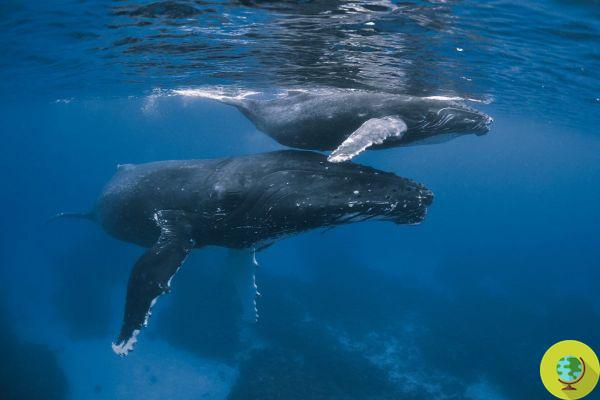
A research team has managed to exploit whale song to understand what happens, at a geological and seismic level, in the oceanic crust
He is about to end up run over, his mother saves himTheir song is a mystery that has fascinated scientists for decades. Whales have a complicated and suggestive communication system but now a research team has managed to exploit their "words" to study what happens, at a geological and seismic level, in the oceanic crust.
Whale songs can be used for seismic imaging of ocean crust, providing scientists with a new alternative to conventional surveying, according to a new study by researchers at Oregon State University.
What happens at the bottom of the sea? How does the earth's crust change where the human eye cannot go? To reveal it are these incredible creatures. In fact, their songs contain signals that are reflected and refracted within the crust, including the sediments and the underlying solid rock layers. These signals, recorded on seismometers on the ocean floor, can be used to determine layer thickness and other information relevant to seismic research.
“People in the past have used whale calls to track animals and study their behavior. We thought maybe we can study the Earth using these sounds. What we have found is that whale calls can serve as a complement to traditional passive seismic research methods, ”said John Nabelek, professor at Oregon State University's College of Earth, Ocean, and Atmospheric Sciences and co-author of the paper.
These vocalizations are useful not only for understanding animals, but also for understanding their environment.
A casual discovery
Together with Vaclav M. Kuna, who earned his Ph.D., Nabelek was studying earthquakes from a network of 54 ocean floor seismometers positioned along the Blanco fault off the Oregon coast. Back then, they noticed strong signals on seismometers related to the presence of whales in the area.
“After every whale call, if you look closely at the seismometer data, there is a response from Earth,” Nabelek said.
In fact, the call literally bounces off the surface and bottom of the ocean. Part of the sound energy is transmitted through the ground as a seismic wave. The wave then travels through the oceanic crust, where it is reflected and refracted by the oceanic sediment, the underlying basalt layer, and the lower gabbroic crust.
When the waves are recorded by the seismometer they can provide information that allows researchers to estimate and map the structure of the crust. Thus, using a series of whale songs recorded by three seismometers, the researchers were able to pinpoint the position of the whale and use the vibrations of the songs to create images of the layers of the earth's crust.
According to the researchers, this will allow learn more about the physics of earthquakes in the region. The current traditional method of scab imaging can be expensive and invasive because it also involves the use of compressed air guns.
A great help, yet another, offered to man by Mother Nature.
Sources of reference: Oregon State University, Science
READ also:
- Pacific gray whales are dying of hunger: scientists say it could be due to global warming
- Oceanbreath, the song created with the sounds of whales and fish instead of instruments by the guitarist of Subsonica
- The song of one of the rarest whales on the planet has been recorded for the first time


























